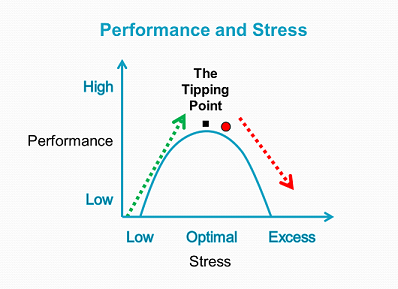When you walk in the room, who shows up for Read more →
The Leader’s Tipping Point
Posted Friday, August 24, 2012By Allen Slade
Leadership is about creating sustainable performance in your team. Jim Clawson points out that effective leadership is “managing energy, first in yourself, then in those around you.” In a post on The Tipping Point of Performance, I talked about managing energy in others to create sustainable performance. As a leader, you have a proven track record of results. You combine competence, capacity and committent to success, so people are willing to follow you. But is your performance sustainable?
Bottom line: As a leader, you have to manage your own energy. Know your performance curve, watch for signs of an impending performance crisis and take dramatic action as needed.
The performance curve is just as true for you as it is for the people you lead. We all experience this inverted-U relationship between stress and performance. A straight line relationship between your level of stress and your performance holds, but only in the green zone.
 If you are in your own green zone, you adjust your effort level to the demands of the situation. Stress triggers higher performance. If you face higher demands, you stay longer, work harder, decide faster. All is well until you reach your tipping point. Then, more stress equals less performance. Further pressure for performance, from yourself or from external demands, drives you into the red zone. You become the red marble accelerating down the performance curve. As a leader, a stress-induced performance crisis not only hurts your productivity, it can undermine your credibility as a leader.
If you are in your own green zone, you adjust your effort level to the demands of the situation. Stress triggers higher performance. If you face higher demands, you stay longer, work harder, decide faster. All is well until you reach your tipping point. Then, more stress equals less performance. Further pressure for performance, from yourself or from external demands, drives you into the red zone. You become the red marble accelerating down the performance curve. As a leader, a stress-induced performance crisis not only hurts your productivity, it can undermine your credibility as a leader.
Bottom line: Push youself, but know your own tipping point. As Bob Rosen says, lead with just enough anxiety.
Manage your own stress wisely, especially on the dangerous part of the performance curve.
Stress reduction strategies. Whether you are at the top of the green zone or at the tipping point, try stress management strategies. Simplify your life. Practice centering. Off load non-essential work. Get help from your boss, in terms of more people, more resources or more time. Ask your colleagues for support. Delegate to your team.
Develop yourself. Long-term, grow your capacity for performance to avoid a stress-induced performance crisis. Develop new skills. Practice skills to the point of mastery. Practice for speed, not just completion. If you can write methodically, practice writing under a deadline. (Blogging three times a week is speeding up my writing!) Coaching can help, whether you are an executive, leader or golfer. At Slade & Associates, we coach executives and leaders to maximize their performance. There are certain things we don’t do, so you would do well to find your own golf coach.
Your urgency in reducing your stress depends on your position on the performance curve:
Top of the green zone. If you push harder but don’t see much improvement, you may be approaching the top of your green zone. Be careful, because you could hit your tipping point. Be alert for further stress, and consider strategies to reduce stressors or increase your performance capacity.
The tipping point. Approaching your tipping zone is dangerous. If familiar tasks become harder, if your inbox is overwhelming, if you snap at reasonable requests or if you work longer with fewer results, you may be at your tipping point. At the tipping point, you still have time. You can think. You can experiment with one stress reducer at a time. Take action now to reduce your stress. Climb back down into the green zone while you can still think clearly.
The red zone. Passing your tipping point is catastrophic because of the accelerating downward spiral of performance. To get out of the red zone, aggressively implement stress management strategies. Make a plan that combines at least two or three big stress reducers – simplify, center, get support from your boss, delegate, etc. Make smart requests ask your boss for support or delegate. Whatever the details, take dramatic action. In the red zone, you must act now.
A lifeguard. I must confess: This red zone advice may not work. The downward spiral of performance undermines your decision making and behavioral flexibility. If you are drowning, sometimes you can’t save yourself. You need a lifeguard who will know you need help and step in during a crisis. Your lifeguard could be a friend, a mentor, a coach or your family. Before a red zone crisis, build strong relationships. Be transparent, accountable and open to constructive feedback. Then, if you are drowning in stress, you will have someone willing to dive in to save you.
Being mindful of the performance curve can help maximize sustainable performance for yourself and for the people you lead. So go lead with just enough anxiety.


An excellent piece of advice for all leaders to take note of and act.